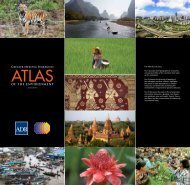ETEE7
ETEE7
ETEE7
You also want an ePaper? Increase the reach of your titles
YUMPU automatically turns print PDFs into web optimized ePapers that Google loves.
Highlights Day 1: 10 March 2013 19<br />
can leverage the various specialties of its member organizations without imposing a burden on member<br />
states, while frontline officers and intelligence officers can cooperate to detect the concealment and<br />
trafficking methods used by wildlife crime syndicates.<br />
B. Key Illicitly and Illegally Traded Species<br />
Ms. Marceil Yeater, chief of the Legal Affairs and Trade Policy Unit of the CITES Secretariat, served as<br />
session chair.<br />
Terrestrial Wildlife Trade<br />
Dr. William Schaedla, regional director of TRAFFIC Southeast Asia, thanked the organizers for inviting<br />
him to speak at this symposium. He then described wildlife crime as multifaceted. Terrestrial animals,<br />
for instance, serve as pets or draft animals, or are traded as fashion commodities, medicine, ornaments,<br />
or meat.<br />
Dr. Schaedla then focused on particular species that are particularly subjected to illegal wildlife trade.<br />
First, pangolins, about eight remaining species of which are widely scattered around the old world tropics,<br />
are traded for use as traditional Asian medicine 7 and as luxury meat. About 40,000 to 60,000 specimens<br />
of pangolins are traded in Asia every year. Between 2000 and 2007, at least 30,000 pangolins were seized<br />
across East Asia and Southeast Asia, and from 2007 to 2009, around 22,200 pangolins were slaughtered<br />
and processed by a single manufacturing plant in Sabah, where large volumes of these pangolins were<br />
seized. Many of these pangolins are extirpated from their habitats in northern parts of Southeast Asia<br />
and in Africa. They are then shipped—alive, frozen whole, or just their dried scales—to East Asia and<br />
Southeast Asia, particularly to the PRC; Hong Kong, China; and Thailand.<br />
Second, slow lorises are traded as pets, meat, and medicine. These species are also part of traditional<br />
pharmacopeia, serving as tonics after childbirth and a cure for wounds and sexually transmitted diseases.<br />
The different purposes for which slow lorises are traded—whether as pets or for medicine—require<br />
different handling regimes and actors, and therefore a targeted enforcement approach. While the pet<br />
trade occurs in end markets in Japan and the US, the medicinal trade occurs within Southeast Asia and<br />
often within East Asia as well. Notably, these species are shipped either dried or manufactured into tonics.<br />
Third, tigers, approximately 3,000 specimens of which remain in the wild, can involve complex trade<br />
chains sourced from various places in addition to protected areas, which may or may not have tigers.<br />
Syndicates usually consolidate these tigers within the Malay Peninsula and Sumatra, Indonesia, and ship<br />
them out in large volumes. TRAFFIC observes a number of ways to move these tigers, a number of players<br />
involved, and increased trade, as TRAFFIC speculates that certain traders are planning to establish farming<br />
facilities. Law enforcement operations have caught traders selling tiger skins, tiger wine with bones, and<br />
7<br />
Pangolin scales are considered indispensable in pharmacopeia.





